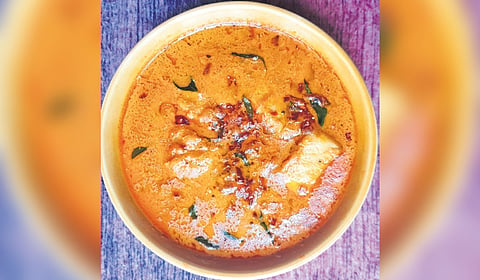

God’s own country, Kerala is known for its picturesque landscape, and coastline, and also has a diverse food culture which is very unique. The three main communities — Hindu Pandits, Christians, and Muslims — have their own drastically different food habits and cuisines with the common undertone of coconut oil, coconut, spices, and fresh produce.
The origin of the Syrian Christian culinary heritage dates back to the time of St Thomas coming to India and his followers intermingling with the powerful landowners of the area. The Portuguese, Dutch, Arab, and British influences along with their integration of local food habits have given rise to a beautiful cuisine that has made an indelible place for itself in the culinary map of the world.
Like most others, Syrian Christian culinary is defined by the indigenous produce and the various cultures that have influenced it. The diet is predominantly non-vegetarian with a higher enthusiasm for seafood which is fresh and plentiful in this water world. Even in the humblest home one can be assured of sardines and tiny shrimps to carry a meal.
Rice is the staple here as it grows in plenty. Red rice or matta rice is used commonly either as a gruel or as rice to be the base of most meals. This red matta rice is healthier than its white counterpart due to the higher content of B vitamins, fibre and hence a lower glycemic index. Rice is also powdered to be used to make steamed delicacies like puttu, idiyappam, fried specialties like kuzhalappam, and rose cookies, or pan-fried delicacies like appam.
Kerala and coconut go hand in hand. Coconut in various forms like fresh, ground, roasted, or coconut milk is used in most recipes. Coconut milk gives a nice creamy, velvety texture to curries and also mellows down the spice levels. Coconut oil is the preferred cooking medium and imparts a unique flavour to the cuisine making it a hallmark of this regional cuisine. Other key ingredients like tapioca, banana, and breadfruit are used in different ways along with pepper, jaggery, kokum, shallots, and curry leaves.
Kitchens in the state are traditional and large and can be found in bigger homes, estate bungalows, and some of the humble farmhouses. They rely on wood-fired cooking and every dish requires different amounts of wood. The heat of the wood-fired stoves is controlled by the amount of wood placed in the fire — a slow steady flame for cooking kanji, a vigorous fire for the swiftly-prepared shrimp olarthiyathu, a slow-burning fire for fish curries, and a few glowing embers are taken and to be placed over appam chatty for delivering the heat from above too.
Similarly, different types of vessels are used for the different methods of cooking. Dishes like puzhangiathu (steamed) are cooked in a chembu made of copper, brass, or aluminum, chennai chatti, literally translating to Chinese pot, is used to cook olarthiyathu and for deep frying. This a round-bottomed pan with two handles similar to a wok and usually made of brass or iron. The rounded bottom helps in the uniform spreading of heat. Uruli a special shallow vessel that is heavy and made of bell metal is found in every home. As it heats up slowly and retains heat for a longer time, it is used for roasting and making desserts with a longer cooking time.
Some historians believe that Kerala’s popular breakfast dish appam, a fluffy, crispy, lacy pancake made from fermented rice and coconut, has its origin from the Dutch pancakes. Many other dishes of the Syrian Christian cuisine speak of their European influence like cutlets from the British, soups from Portuguese, and so on. Another star dish, fish moilee is believed to have origins from Malay, where the idea of cooking fish in coconut milk started.
The use of kappa (tapioca) is typical of Syrian Christian cuisine. Starchy and full of carbohydrates, it is a great source of instant energy and is incredibly satisfying on its own or when served with a fiery red and spicy kudampuliyitta fish curry. Another popular dish is the pidi, a one-pot dish where small rice dumplings are cooked in a meat curry, and as a result, they absorb the flavour of the curry making it very special. This is very similar to the Tamil thakkidi.
Vattayappam, a slightly sweet, steamed, fermented rice cake that is fluffy and spongy is yet another star dish. They can be had as a snack or a meal with curry or coconut milk. They are so spongy that they literally soak up any liquid. They are usually fermented with yeast and served with mild curries like stew or mappas. The latter is a mild yet flavourful curry with hints of pepper. Mappas pair beautifully with appam, idiyappam, parotta, and chapati.
Chicken/Mushroom Mappas
Ingredients
Chicken/ Mushroom: 250 g
Onion: 1, sliced
Ginger: 1 tbsp, chopped Garlic: 1 tbsp
Chopped Curry leaves
Red chilli: 2, Cloves: 3
Cinnamon: 2
Cardamom: 3
Coconut milk: 2 cups
Fresh pepper: 1 tbsp
Turmeric: 3 tsp
Coriander powder: 1 tbsp
Saunf powder: 1/2 tsp
Coconut oil: 2 tbsp
Method
Heat coconut oil and add whole spices. Then add onion, garlic, and ginger and sautè till light brown.
Add salt, and spice powders mixed with a tablespoon of water and sautè till oil separates.
Add the meat or mushroom and cook till almost done.
Add coconut milk, cook for two minutes, and serve hot.
Dr Nithya Franklyn
@drnithyafranklyn
(Dr Nithya Franklyn is a paediatrician, chef, and MasterChef Tamil finalist)